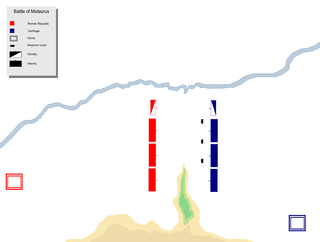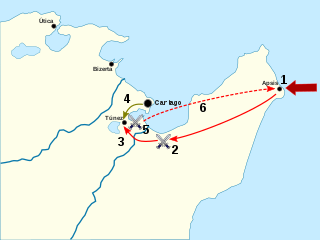
The First Punic War was the first of three wars fought between Rome and Carthage, the two main powers of the western Mediterranean in the early 3rd century BC. For 23 years, in the longest continuous conflict and greatest naval war of antiquity, the two powers struggled for supremacy. The war was fought primarily on the Mediterranean island of Sicily and its surrounding waters, and also in North Africa. After immense losses on both sides, the Carthaginians were defeated.

Hannibal was a Carthaginian general and statesman who commanded the forces of Carthage in their battle against the Roman Republic during the Second Punic War.
Hamilcar Barca or Barcas was a Carthaginian general and statesman, leader of the Barcid family, and father of Hannibal, Hasdrubal and Mago. He was also father-in-law to Hasdrubal the Fair.

Hasdrubal Barca, a latinization of ʿAzrubaʿal son of Hamilcar Barca, was a Carthaginian general in the Second Punic War. He was the brother of Hannibal and Mago Barca.

The Battle of Himera, supposedly fought on the same day as the Battle of Salamis, or at the same time as the Battle of Thermopylae, saw the Greek forces of Gelon, King of Syracuse, and Theron, tyrant of Agrigentum, defeat the Carthaginian force of Hamilcar the Magonid, ending a Carthaginian bid to restore the deposed tyrant of Himera. The alleged coincidence of this battle with the naval battle of Salamis and the resultant derailing of a Punic-Persian conspiracy aimed at destroying the Greek civilization is rejected by modern scholars. Scholars also agree that the battle led to the crippling of Carthage's power in Sicily for many decades. It was one of the most important battles of the Sicilian Wars.

The Mercenary War, also known as the Truceless War, was a mutiny by troops that were employed by Carthage at the end of the First Punic War (264–241 BC), supported by uprisings of African settlements revolting against Carthaginian control. It lasted from 241 to late 238 or early 237 BC and ended with Carthage suppressing both the mutiny and the revolt.

The Battle of the Metaurus was a pivotal battle in the Second Punic War between Rome and Carthage, fought in 207 BC near the Metauro River in Italy. The Carthaginians were led by Hasdrubal Barca, brother of Hannibal, who was to have brought siege equipment and reinforcements for Hannibal. The Roman armies were led by the consuls Marcus Livius, who was later nicknamed the Salinator, and Gaius Claudius Nero.

The Battle of the Bagradas River, also known as the Battle of Tunis, was a victory by a Carthaginian army led by Xanthippus over a Roman army led by Marcus Atilius Regulus in the spring of 255 BC, nine years into the First Punic War. The previous year, the newly constructed Roman navy established naval superiority over Carthage. The Romans used this advantage to invade Carthage's homeland, which roughly aligned with modern-day Tunisia in North Africa. After landing on the Cape Bon Peninsula and conducting a successful campaign, the fleet returned to Sicily, leaving Regulus with 15,500 men to hold the lodgement in Africa over the winter.

The Oretani or Oretanii were a pre-Roman ancient Iberian people of the Iberian Peninsula, that lived in northeastern Andalusia, in the upper Baetis (Guadalquivir) river valley, eastern Marianus Mons, and the southern area of present-day La Mancha.

The Battle of the Saw was the culminating battle of a campaign fought between a Carthaginian army led by Hamilcar Barca and a rebel force led by Spendius in 238 BC in what is now northern Tunisia. Carthage was fighting a coalition of mutinous soldiers and rebellious African cities in the Mercenary War which had started in 241 BC. The rebels had been besieging Carthage while the Carthaginian field army under Hamilcar raided their supply lines. Under this pressure the rebels pulled back to their base at Tunis and despatched their own army to prevent Hamilcar's activities and, ideally, destroy his army.

Hasdrubal the Fair was a Carthaginian military leader and politician, governor in Iberia after Hamilcar Barca's death, and founder of Cartagena.

The Battle of Ibera, also known as the Battle of Dertosa, was fought in the spring of 215 BC on the south bank of the Ebro River near the town of Ibera and was part of the Second Punic War. A Roman army, under the command of the brothers Gnaeus and Publius Scipio, defeated a similarly sized Carthaginian army under Hasdrubal Barca. The Romans, under Gnaeus Scipio, had invaded Iberia in late 218 BC and established a foothold after winning the Battle of Cissa. This lodgement, on the north-east Iberian coast, between the Ebro and the Pyrenees, blocked the route of any reinforcements from Iberia for the army of Hannibal, who had invaded Italy from Iberia earlier in the year. Hasdrubal attempted to evict the Romans in 217 BC, but this ended in defeat when the Carthaginian naval contingent was mauled at the Battle of Ebro River.
The military of Carthage was one of the largest military forces in the ancient world. Although Carthage's navy was always its main military force, the army acquired a key role in the spread of Carthaginian power over the native peoples of northern Africa and southern Iberian Peninsula from the 6th century BC and the 3rd century BC. Carthage's military also allowed it to expand into Sardinia and the Balearic Islands. This expansion transformed the military from a body of citizen-soldiers into a multinational force composed of a combination of allies, citizens and foreign mercenary units.
Lucius Valerius Flaccus was a Roman statesman and general during the middle era of the Roman Republic. He was one of the two consuls of 261 BCE, serving with Titus Otacilius Crassus. Together they fought in the ongoing First Punic War; they campaigned in Sicily. Before sailing to Sicily they strengthened the coastal defences of Italy against attacks by Hannibal Gisco, a Carthaginian admiral sent to raid the Tyrrhenian coast. The consuls besieged Mytistraton, but were eventually driven off by Hamilcar, the new commander of Carthage's Sicilian army, who inflicted a defeat on them at Thermae near Palermo. They returned to Italy were they started building a fleet. This fleet was the first Roman fleet of war ships ever and created after Carthaginian example. In 260, this fleet was ready.

The Germani were an obscure pre-Roman ancient people of the Iberian Peninsula which settled around the 4th century BC in western Oretania, an ancient region corresponding to the south of Ciudad Real and the eastern tip of Badajoz provinces.
During the siege of Tunis in October 238 BC a rebel army under Mathos was besieged by a Carthaginian force under Hamilcar Barca and Hannibal. The Carthaginian army, which had served on Sicily during the First Punic War, mutinied in late 241 BC in the wake of Carthage's defeat, starting the Mercenary War. After three years of increasingly bitter war, the Carthaginians defeated the rebel field army at the Battle of the Saw, capturing its leaders. The Carthaginians then moved to besiege the rebels' strongest remaining stronghold at Tunis.
Hamilcar's victory with Naravas took place in 240 BC in what is now north-west Tunisia. A Carthaginian army led by Hamilcar Barca defeated a rebel army led by Spendius and Autaritus, after 2,000 Numidian cavalry led by Naravas defected from the rebels to Carthage. The precise location location of the battle is unknown. Carthage was fighting a coalition of mutinous soldiers and rebellious African cities in the Mercenary War which had started in 241 BC.
Titus Otacilius Crassus was a Roman statesman and general during the middle era of the Roman Republic. He was one of the two consuls of 261 BCE, serving with Lucius Valerius Flaccus. During his consulship, he and his consular colleague Flaccus fought against the Carthaginians on Sicily as part of the ongoing First Punic War. Before sailing to Sicily they strengthened the coastal defences of Italy against attacks by Hannibal Gisco, a Carthaginian admiral sent to raid the Tyrrhenian coast. The consuls besieged Mytistraton, but were eventually driven off by Hamilcar, the new commander of Carthage's Sicilian army, who defeated them at Thermae near Palermo. They returned to Italy were they started building Rome's first warfleet, created after Carthaginian example. In 260, the fleet was ready and would be used by Gnaeus Cornelius Scipio Asina, one of the two consuls of that year.

Warfare in ancient Iberian peninsula occupied an important place in historical chronicles, first during the Carthaginian invasion of Hispania, including the Punic Wars, and later during the Roman conquest of the peninsula. The densely bellicose character of the Pre-Roman peoples who inhabited Hispania was repeatedly shown in their conflicts against Rome, Carthage and each other.
Indortes was an Iberian warlord from the first half of the 3rd century BC. He succeeded Istolatios in command of the Turdetan and Iberian revolt against the Carthaginians of Hamilcar Barca.











